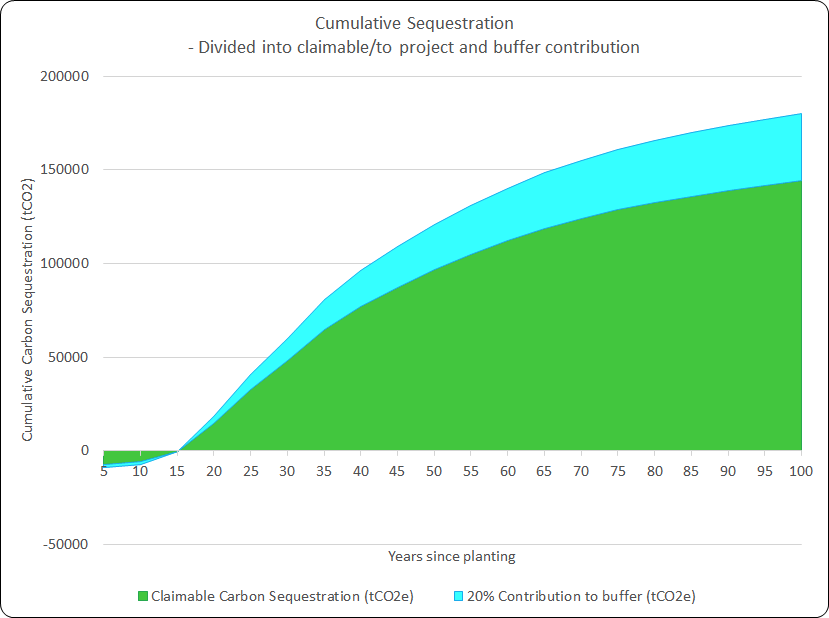 I had said I would follow my post looking at the impact of BrewDog’s tree planting at Kinrara (see here) with one that looked at the impact of the new deer fences. However, having looked at further further information about BrewDog’s carbon emissions at Kinrara, it seems more important to cover that first.
I had said I would follow my post looking at the impact of BrewDog’s tree planting at Kinrara (see here) with one that looked at the impact of the new deer fences. However, having looked at further further information about BrewDog’s carbon emissions at Kinrara, it seems more important to cover that first.
The carbon emissions caused by the construction of the Lost Forest
In my last post I argued that just by looking at the disturbance to the peaty soils, the size of the new trees and the number that had died at Kinrara, it was not difficult to envisage it might be years before the new “forest” replaced the carbon emitted by the planting. I have subsequently checked these observations with the information for Kinrara recorded on the UK Land Carbon Registry (see here).
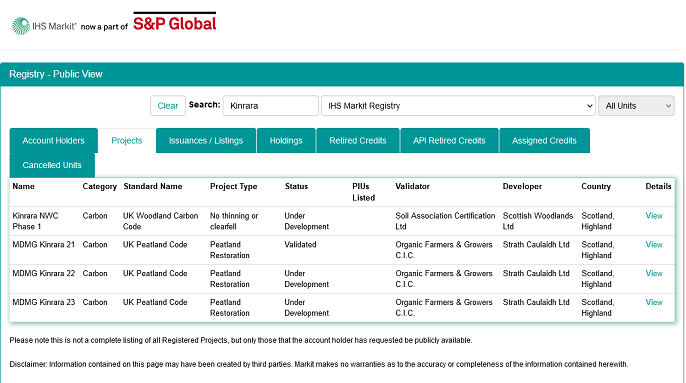
This shows that four carbon offsetting schemes have been registered on behalf of BrewDog. Among the information in the Carbon Calculator spreadsheet for the Lost Forest Phase 1 is the graph at the top. By their own calculations it will be at least 15 years before the Lost Forest recoups the carbon emitted during its planting and the Lost Forest will start offsetting carbon. This scenario depends, however, on some basic assumptions used in the calculations being met.
As I showed in my last post, a large numbers of trees BrewDog planted died this summer. While the number needs to be verified by Scottish Forestry, whose grant to BrewDog was dependant on how many trees survive, from what I saw the dead trees were well over 20% “buffer” provided for in the calculations (as marked in blue on the graph above). This means either not as much carbon will be absorbed by the woodland as predicted or more trees will have to be planted, incurring further carbon emissions. Either way the timescale for this project to become net zero is likely to increase from 15 years.
There appears, however, to be some more fundamental problems with the calculation:
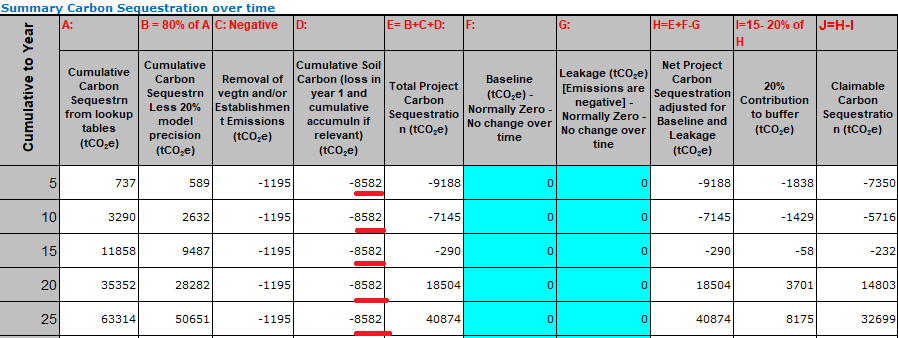
The spreadsheet includes two sources of carbon emissions caused by the project: “Establishment emissions”, including vegetation removal; and cumulative loss of soil carbon. What column D shows is that NO allowance has been made for CUMULATIVE loss of soil carbon despite the fact that peat exposed by mounding oxidises at a rate of c2cm a year (hence why the restoration of bare areas of peat is so important). It appears, therefore, to be a significant underestimate.
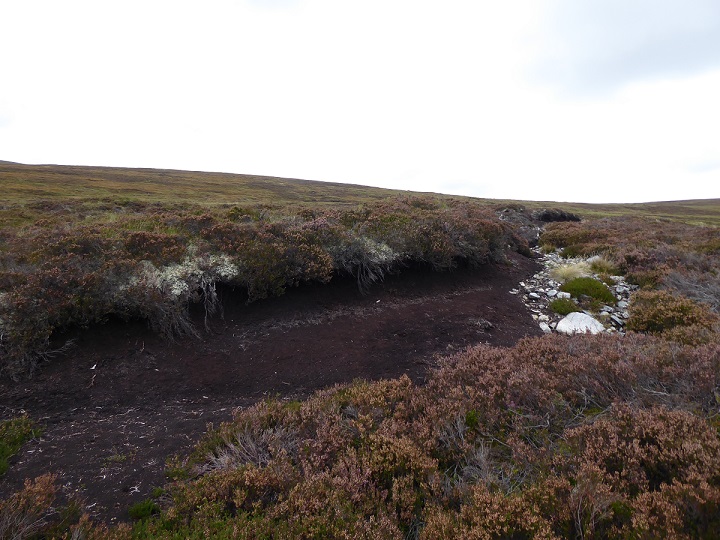
“Establishment” costs are clearly normally associated with the start of a project, although the Woodland Carbon Code rightly requires them to be revised where further inputs are needed (e.g. to replace trees that have died). The way this has been calculated to date, however, again underestimates the amount of carbon emitted:
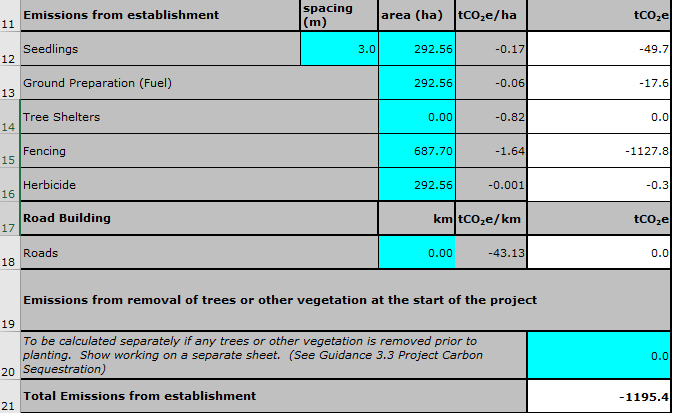
Fuel for machinery is included but NOT the fossil fuels required to manufacture that machinery or import it. Most of those carbon costs are often wrongly shunted onto other countries carbon balance sheets (particularly China) but to BrewDog’s credit when it comes to the brewing of beer it includes them in its Scope 3 emissions (carbon for which it is not directly responsible). It should do the same for the Lost Forest.
The entry in Row 20 records that there were zero emissions from vegetation removal. Even without knowing the site, you can tell that is not true from row 16. This shows that the application of herbicide used to kill off vegetation around the mounds emitted 292.56 tons of CO2. Recent research suggests that the carbon contained in the vegetation and peaty soils on (unburned) heather moorland is often equivalent to birch woodland which is now being planted over much of Kinrara.
In summary, the calculation of the amount of CO2 emitted by the planting of the Lost Forest is not fit for purpose and the public would be far better trusting the research by Friggens et al which has been accepted by the Woodland Trust – but not apparently by Forestry Scotland – which shows that native woodland planted on peaty soils is likely to be a net emitter of carbon for over 40 year (see here). That threatens the Cairngorms National Park Authority’s aspirations (see here for example) for the National Park to become net zero well before the Scottish Government’s aims to do so in 2045.
In its accounts for 2021, published last year, BrewDog claimed that the Lost Forest was sequestering CO2 from the atmosphere:
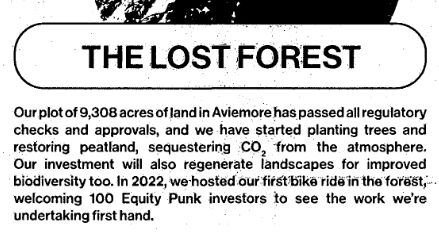
That won’t be true for its tree planting for at least 15 years, and maybe 40 or more.
However, BrewDog is also using Scottish Government money to restore degraded peatland elsewhere on Kinrara. This is a far more sensible option than planting on it. So far just one of the three restoration schemes has been validated and, while there is no pretty graph, there is a spreadsheet showing the “official” calculation of the impact on carbon emissions:
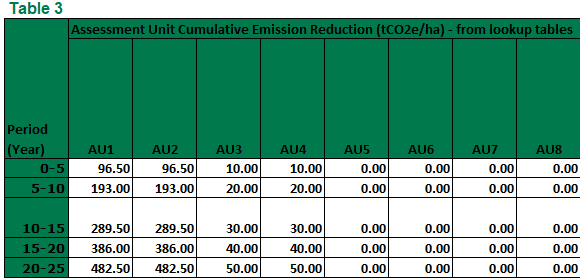
This shows that the total amount of carbon absorbed by this one scheme by year 5 is 213 tonnes of CO2 (tCO2). That is tiny compared to the 9188 tCO2 emitted by the planting. In other words, the official figures used by BrewDog’s consultants shows that the claims they made in their last annual report are wrong. BrewDog’s Lost Forest has been emitting CO2 out into the atmosphere, grant aided by Scottish Forestry (see here).
The Peatland Code calculator is even simpler than the Woodland Code Calculator and does not account for ANY emissions during the restoration process. While covering up peat and replanting vegetation, rather than destroying it, will emit far less carbon than mounding soil to plant trees, there will still be some emissions resulting from peat damaged by the use of heavy machinery and from those vehicles. That will extend the time it will take this peatland restoration to help compensate for the emissions caused planting. In other words, even though peatland restoration is generally a good thing on the Kinrara estate it will take a long time to compensate even for the damaged caused by the planting
BrewDog’s accounts and its “Mega Report” on its carbon emissions for 2022 (see here) have just been published. While there is no explicit statement of the carbon emissions that have been caused by the Lost Forest, there is now an easy to miss acknowledgement of what is actually happening

![]()
“Until the Lost Forest starts sequestering carbon” is the key phrase. There is no indication of when this will be.

 It is of course true that once a tree is either planted or naturally regenerated it will start to sequester carbon from the atmosphere but I could find no mention in either of these documents the carbon that had been emitted in the course of starting to plant those trees. One wonders if the 100 Equity Punk Investors were told?
It is of course true that once a tree is either planted or naturally regenerated it will start to sequester carbon from the atmosphere but I could find no mention in either of these documents the carbon that had been emitted in the course of starting to plant those trees. One wonders if the 100 Equity Punk Investors were told?
BrewDog’s carbon accounting challenge and its implications
The 2022 accounts for BrewDog’s Lost Forest subsidiary, were due at the end of September but should be published next week. Perhaps they will say something about the emissions caused by the planting? Maybe not, with the main planting having taken place this year, but if that is the case there will be no excuse for BrewDog not to show this information in a year’s time in its 2023 accounts and “Mega Report”.
BrewDog has committed to going beyond net zero and claims to be doing so at present by buying carbon credits from the Nature Conservancy in Canada. Logically, it should now be buying more carbon credits to compensate for its work at Kinrara until that achieves net zero. BrewDog’s intention appears to have been to use carbon credits from Kinrara to replace those it had purchased in Canada: that now seems a long way off.
This raises the question, what if some of those credits purchased in Canada were linked to new tree planting on peaty soils which itself was emitting carbon?
The evidence from Kinrara suggests that the whole idea that planting trees on peaty soils can do anything meaningful to offset carbon emissions is extremely dubious. Responsibility for this is not entirely BrewDog’s fault but a consequence of Scottish Government policy and the Forest Grants system, which still allows planting on peaty soils. Its time that the Cairngorms National Park Authority and NatureScot spoke out but unfortunately they appear too in thrall to a flawed idea, and the vested interests that have promoted this, to do so.
Carbon dioxide is an essential gas for life on earth, and as the greening of areas formerly classed as desert demonstrates, is entirely beneficial to life on earth, indeed necessary in order for it to continue. 95+% of co2 is naturally generated, with the remainder being man made. The crusade against carbon dioxide is just that, a ridiculous religion based not in science but in ideology.XXXXXXXXXXXXXXXXXXXXXXXXXXXXXXXXXXXXXXXXXXXXXXXXXXXXXXXXXXXXXXXXXXXX
In response to a similar comment from yourself recently I posted this “No-one is saying CO2 isn’t essential to life but tiny changes in the the concentrations in the atmosphere have a massive impact on the heat of the world, the greenhouse effect. You are wrong to claim these concentrations haven’t changed. They have increased to 421 parts per million (ppm) or about 0.04% (as of May 2022) as you say but from pre-industrial levels of 280 ppm or about 0.025%. That is a huge increase given how CO2 “works” and the primary cause is the burning of fossil fuels. While concrete is a lesser but significant contributor of emissions your claims about 97% of carbon emissions coming from volcanoes is bunkum . I only publish comments like yours to show just how much misinformation is being circulated? My thanks to the reader who posted the information about Murray Salby.”
You have not bothered to answer. That’s your right but climate deniers who refuse to engage in dialogue or consider the evidence have enough media outlets without parkswatch adding to them.
This is a timely post on Parkswatch because Andy Wightman has addressed the same subject on his Land Matters blog in recent days. It is worth reading the two articles, as they are both pointing out some serious flaws in government policies on carbon markets.
https://andywightman.scot/2023/11/why-scotland-should-stop-selling-carbon/